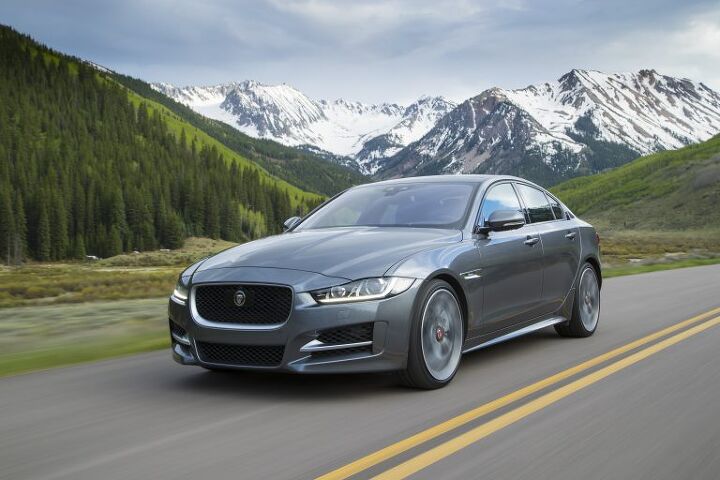Jaguar Was America's Fastest-growing Auto Brand in 2016, and Not Just Because of an SUV
Jaguar Land Rover North America LLC sold its first 10,016 Jaguar SUVs in the United States in the final eight months of 2016. The new F-Pace was a major factor contributing to Jaguar’s 116-percent year-over-year growth last year.
Jaguar also reported a 47-percent jump in passenger car sales — yes, car sales — in 2016.
As a result, no auto brand operating in the United States posted more significant sales growth in 2016.
So, Jaguar’s back? Not quite.
Globally, Jaguar Land Rover — and even the Jaguar brand itself — has never been more popular. Jaguar sold a record-high 148,730 new vehicles around the world in 2016. Three-in-ten were F-Paces.
Around the world, 25 percent of the vehicles sold by Tata’s JLR in 2016 were Jaguars, up seven points compared with 2015.
Yet in the U.S., specifically, Jaguar’s sales in 2016 were only half as strong in 2016 as they were 14 years ago.
In 2002, Jaguar USA, then under Ford Motor Company’s control, sold 61,204 new vehicles. Jaguar’s lineup was strikingly different and decidedly retro.
The entry-level Ford Mondeo-related X-Type accounted for more than half of the Jaguars sold in America in 2002, and sales of the flagship XJ were twice as numerous as they are now — and still on the rise.
Jaguar got back into the entry-luxury sports sedan game in the second quarter of 2016, launching the new XE in concert with the new F-Pace. XE sales are steadily rising, but Jaguar is only selling around 800 XEs per month in the U.S., roughly one-third the volume the X-Type generated at its peak.
Jaguar also introduced in 2016 a new XF, the brand’s mid-range car. XF sales consequently climbed to a three-year high.
In the passenger car world, “new” did not necessarily equal “more popular” in 2016. The launch of a new Mercedes-Benz E-Class — a segment leader in the XF’s arena — resulted in a 9-percent year-over-year decline. Naturally, the XF remains a low-volume car, but the new XF was able to ride Jaguar’s wave, posting improvements in eight of the last twelve months.
Jaguar’s F-Type, the lone remaining sports car in the range, was the only model in the lineup to lose sales compared with 2015. F-Type volume slid 12 percent, a loss of 560 units. Jaguar XJ sales grew 6 percent, a modest uptick of 223 units compared with 2015.
Even if Jaguar’s passenger car lineup had not recorded growth in 2016, the surge produced by the brand’s first-ever SUV would have been more than enough to make Jaguar America’s fastest-growing auto brand. Since the F-Pace launch in May, four out of every ten Jaguars sold in America were F-Paces.
Fastest-GrowingOf course, rapid percentage growth at a niche brand such as Jaguar (or Volvo, a former Ford PAG brand that jumped 18 percent) is easier to produce than at mainstream volume brands. Gains in market share were much more significant at Ram, Jeep, Subaru, Nissan, and Honda. Those brands averaged growth of an extra 56,500 sales in 2016.
Jaguar, admittedly with an impressive response to a wise investment, added merely 16,777 sales to its U.S. ledger.
Yet even if Jaguar carries 2016’s Q4 sales pace through the whole of 2017, the brand’s dealers will still be selling roughly 30-percent fewer new vehicles than they did in 2002.
Ram, Jeep, Subaru, Nissan, and Honda, on the other hand, all reported all-time record U.S. sales in 2016.
Timothy Cain is the founder of GoodCarBadCar.net, which obsesses over the free and frequent publication of U.S. and Canadian auto sales figures. Follow on Twitter @goodcarbadcar and on Facebook.
More by Timothy Cain
Latest Car Reviews
Read moreLatest Product Reviews
Read moreRecent Comments
- Shoulderboards I like most of what the Jetta delivers. A couple of gripes. Lose the red stripe under the front end, the 1980 ‘s left 36 years ago.A proper 6-speed manual transmission should at least be an available feature if the DSG must be standard.
- Fred I like the digits for the speedometer, simple easy to read.
- Fred My TLX has a trunk with no hooks for a net so I got one of those trunk organizers. Just a cheap one from Amazon. Something to keep the groceries from sliding and spilling all over.
- Kjhkjlhkjhkljh kljhjkhjklhkjh its not even 2026 yet ... recall
- Mnemic Muscle cars are the only CARS still selling. Look up top 10 coupe sales from 5-6 years ago. Damn corvettes were outselling 2 door honda civics. Mustang, Challenger and Camaro were top 3 and by a huge margin, nothing else came close. With Charger being so huge there is room for Dodge to make a smaller coupe



































Comments
Join the conversation
yeah, i 'memmer the early oughts. seemed there were a crapton of jag/fords around, mostly X types.
The XE is more expensive than the previous X-type. That car was advertised for $30,000 but in reality, a well equipped X-type was about $35,000 in 2002, and a top of the line VDP X-Type was $40,000 in 2005. I just got a fairly well equipped 2017 XE that listed for $55,000 and they go as high as $60,000, notwithstanding that they are advertised for $37,500. The XE is a great car, but i think that sticker shock is a factor in the lower comparable sales the article points out.